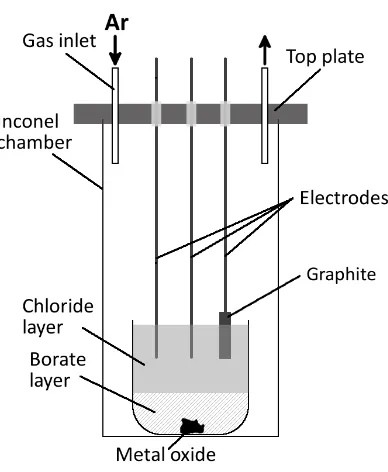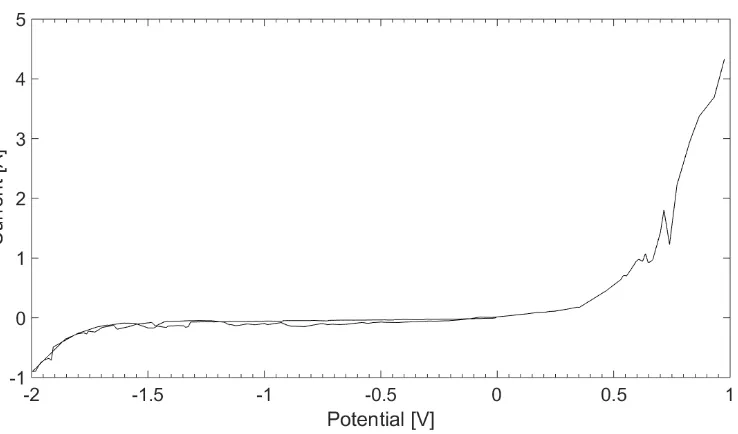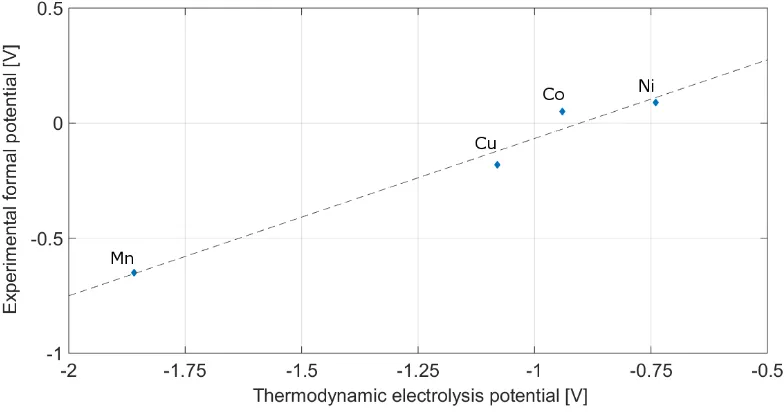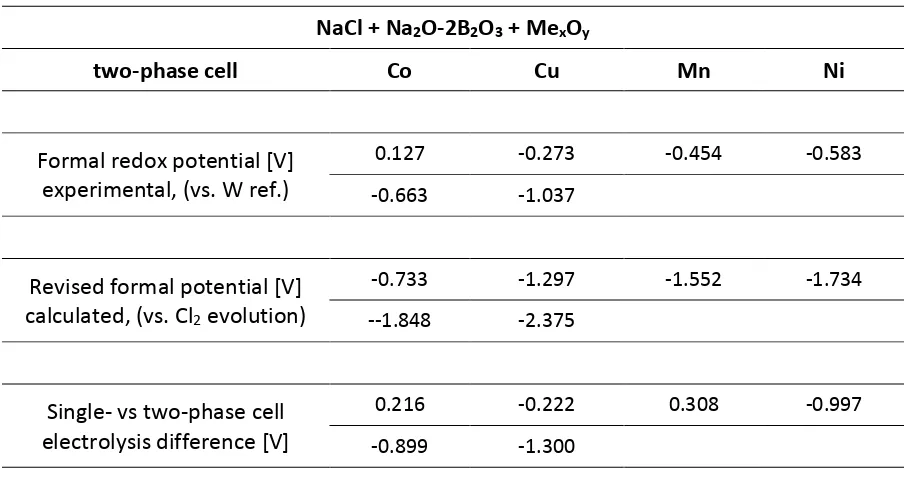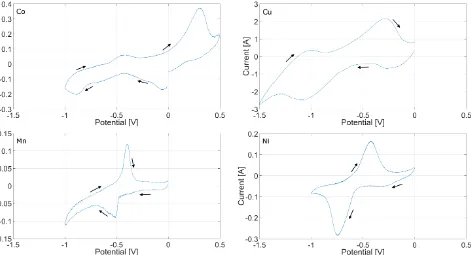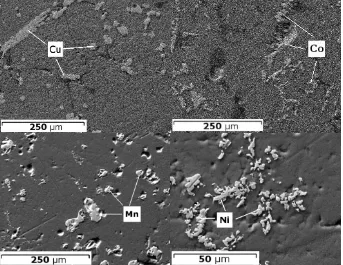warwick.ac.uk/lib-publications
Original citation:Amietszajew, Tazdin, Seetharaman, Sridhar and Bhagat, Rohit. (2016) Metal recovery by electrodeposition from a molten salt two-phase cell system. Journal of The Electrochemical Society, 163 (9). D515-D521.
Permanent WRAP URL:
http://wrap.warwick.ac.uk/80428
Copyright and reuse:
The Warwick Research Archive Portal (WRAP) makes this work by researchers of the University of Warwick available open access under the following conditions. Copyright © and all moral rights to the version of the paper presented here belong to the individual author(s) and/or other copyright owners. To the extent reasonable and practicable the material made available in WRAP has been checked for eligibility before being made available.
Copies of full items can be used for personal research or study, educational, or not-for-profit purposes without prior permission or charge. Provided that the authors, title and full
bibliographic details are credited, a hyperlink and/or URL is given for the original metadata page and the content is not changed in any way.
Publisher’s statement:
Final publication: http://jes.ecsdl.org/content/163/9/D515.abstract
A note on versions:
The version presented here may differ from the published version or, version of record, if you wish to cite this item you are advised to consult the publisher’s version. Please see the ‘permanent WRAP URL’ above for details on accessing the published version and note that access may require a subscription.
Metal recovery by electrodeposition from
a molten salt two-phase cell system
Tazdin Amietszajew
1*, Seetharaman Sridhar
1, Rohit Bhagat
11
WMG, University of Warwick, Coventry CV4 7AL, UK
*T.Amietszajew@warwick.ac.uk
ABSTRACT
A novel electrochemical recovery method of Co, Cu, Mn and Ni from a reactor based on two
immiscible molten phases, to enable selective metal plating, sufficient feedstock dissolution
and protection from re-oxidation, was designed and characterised through voltammetry and
chronoamperometry. The immiscible phases in the electrolytic cell were NaCl and Na
2O-2B
2O
3at 1173 K, and the metal feedstock to be recovered was either metal chlorides or metal oxides
of Co, Cu, Mn and Ni. Metals could be successfully recovered as plated metal deposits and the
formal redox reaction potentials were reported. Metals thermodynamic behaviour
differences between the cells were analysed. Analysis of the metal deposits showed that the
recovered metals were of high purity (
∼
99%). This offers an alternative method to recycle
I.
Introduction
Despite the constant improvements in the metal processing technology, valuable metals recovery from scrap and e-waste stream is still lacking. Recovery of such metals is of high interest both in EU1 and USA2 when considering a foreseeable constraints in raw materials availability and energy costs of extraction in a future society. In the US alone, each year at least 94 million USD worth of non-ferrous metals are disposed of as land-fill3, while the global e-waste recycling rate was estimated to be less than 20% in 20094, in part due to lack of relevant recycling technology. Rapid development of Li-Ion and NiMH battery technology causes increased consumption of Co, Cu, Mn, Ni, Zn and Li5–7, with Li-Ion cells (together with NiMH) accounting for over 80% of the rechargeable batteries market8. Methods currently available for these metals recovery are adapted pyro- or hydro-metallurgical9 minerals processing operations8. As a result, not being originally developed for this purpose, these methods cause losses of raw material or ignore specific metal streams altogether, e.g. recovering some and slagging other elements8. Additionally, the majority of these processes produce significant amounts of water waste, relying on leeching or other water-based solutions. Such methods requires highly corrosive acids use, which are environmentally damaging and contaminate the waste water heavily, including sulphates by-products presence10–13. For these reasons, new metal recovery methods research is necessary for the technological development and as an alternative to the existing processes.
Additional stream of rare and valuable metals is possible in form of metal hyperaccumulating plants. A range of plants (e.g. fungi, some wild plants) was reported to be capable of removal of heavy-metal from contaminated soil (e.g. near roads). This way the soil can be cleared for revitalisation, while metals are concentrated in the plant roots and shots. Such plants are then incinerated, and the metal-rich powder requires post-processing for metal recovery14,15.
Molten salts present an alternative to water based metal processing methods, and are already used in a diverse range of processes, such as extraction16, purifying17 and coating18. Technical barrier towards developing an electrochemical based recovery process include: achieving sufficient dissolution of the metal in the electrolyte and the re-oxidation of the metal after winning. A further technical challenge is the selective winning of various elements from a feedstock. Using a two phase system could solve the difficulty of dissolving the metal feed efficiently and without a need for expensive atmosphere control, while retaining electrochemical properties and cleanliness of the second phase. The method presented in this article uses molten borates, known mainly for boriding19,20 and glass forming21,22, and molten chlorides, widely used in electrochemistry (electrodeposition23, alloy formation24 and nano-structured carbon materials formation25. However, the thermodynamic properties of molten salts are by far less understood than water-based chemistry. Currently and at the moment of writing this article the literature and information regarding thermodynamics of specific molten salt systems is scarce26.
Borates has been partly studied for their high metal solubility application in metal extraction27. Furthermore molten borate and molten chloride has been studied as immiscible phases28. It has been suggested that borates are capable of dissolving significant quantities of metal species, and presents a feasible basis for metal recovery process. As the borates are thermodynamically stable oxides, they can work in open atmosphere without risk of reaction with moisture or oxygen in the air. Any impurities in the feedstock in contact with borates melt would safely dissolve into the melt or pyrolyse due to the high temperature of the molten salt.
electrochemistry requires atmosphere control (neutral gases) and additional control measures due to possible salt evaporation33 and chlorine formation.
The process proposed is based on a liquid-liquid extraction, essential step possible thanks to the immiscibility phenomenon common for the molten alkali borates and molten halides systems. This is due to the highly polymeric nature of molten borate, in contrast to purely ionic structure of the latter34,35. The molten salts liquid-liquid interface transfer mechanism was previously reported in the literature28.
Considering the economical side of the process, it offers certain benefits over hydrometallurgical methods. The process proposed uses two salts (sodium chloride and borax) for the bulk of the cell, which are naturally occurring and quite prevalent36,37. This removes the adverse environmental impact of heavily corrosive and expensive acids use (e.g. sulfuric acid, hydrofluoric acid), which is an issue when hydrometallurgical processes are considered11. This also allows for zero water waste process, when the contaminated water disposal is a growing financial factor and under the pressure of the pro-ecological approach and governmental incentives to reduce the waste output. Regarding the feed pre-treatment, hydrometallurgical methods require small particle size for the leeching to reach required concentrations12,38 which adds the milling step and quite often thermal pre-treatment, while the evaluated method can efficiently work on pellet-size metal sources even without any additional mixing.
Metal recovery can be highly beneficial, as it is one of the most profitable processes in the waste treatment industry39. It is evident that the largest part of the evaluated process cost would be the heat-generation for the melt and electricity cost for the electrolysis, making the price-per-mass-unit of the recovered metal relatively high. However, with proper engineering design the process could partially rely on the residual heat widely present in the metal industry. Furthermore, while currently electricity prices would make the method rather expensive, the electricity cost would be driven low by other research sectors, i.e. nuclear and renewable sources, promoting electrolysis based systems. Additionally, with the development of the process and the metal industry needs, the benefits of complete and diverse metals recovery and wide range of possible feedstock would potentially outweigh the cost, especially including the increasing waste disposal rates and limitations.
This study focuses on the recovery of the Cu, Co, Ni and Mn metal, constituents in spent batteries, from the borate-chloride two-phase molten salt system at 1173 K. Experiments have been carried out in both single (chloride) and two-phase (borate-chloride) salt systems, in a test set-up specifically designed for molten-salt electrolysis. Transient electrochemical techniques like cyclic voltammetry and chronoamperometry have been used for the electroreduction and process evaluation, as well as energy dispersive X-ray spectroscopy, inductively coupled plasma optical emission spectroscopy and X-ray diffraction for the analysis of the processed materials.
II.
Methods
Test set-up
The electrochemical experiments were carried inside a vertical tube furnace, in a set-up presented in Figure 1. The tests were conducted inside a gas-tight Inconel® tube with argon atmosphere, allowing for O2 levels as low as 50ppm. An alumina crucible (Coors™, high-alumina crucible, 100ml) was used to contain the melt which consisted of 35g of sodium borate (Na2O-2B2O3, Sigma-Aldrich
®
, anhydrous, >98.0 %) and 65g of sodium chloride (NaCl, Sigma-Aldrich®, Redi-Dri™, anhydrous, >99 %). A metaloxide pellet (~10g) was inserted at the bottom.
The borate salt layer was saturated with the feed prior to the test, and subsequently allowed to equilibrate with the molten chloride layer for at least 1h before testing. The process is mainly diffusion controlled as is discussed later in the article, however partial heat convection is plausible promoting faster equilibration. Due to the density differences, the chloride salt (1.50 g/cm3)40 was on top of the borate (2.06 g/cm3)41 layer, which with the mass differences resulted in the chloride layer being twice the height of the borate phase, allowing for easier electrode placement. The oxides selected for the experimentation were the most stable oxides of their respective metals at the test temperature (1173 K)26,42. Depending on the test conducted, the metal oxide was one of the following: NiO (99,8 %), Co3O4 (99,5 %), CuO (98 %) and Mn2O3 (99 %) from Sigma-Aldrich®.
[image:5.595.209.403.451.687.2]Alternatively, in case of the single-phase chloride-only set-up, the crucible was filled with 70g of sodium chloride (NaCl) and the respective stable metal chloride: NiCl2 (>99.0 %), CoCl2 (>99.0 %), CuCl2 (>99.0 %) or MnCl2 (>99.0 %) from Sigma-Aldrich® at 1 wt% for the comparativeness of the tests. All the metals were tested separately in this study. The electrodes were lowered into the melt through insulating Macor® ceramic fittings.
Electrodes used in the process were selected depending on their thermal and corrosion resistance, low thermal expansion and chemical resistance43–47. The working electrode (WE) was a tungsten rod (2mm diameter), Counter Electrode (CE) was a graphite cylindrical block (6mm diameter) on a stainless steel current collector. A tungsten rod (2mm diameter) was adopted as a quasi-reference electrode to avoid introducing impurities. The electrodes surface area in contact with the electrolyte was dependable on the immersion depth (as visible in Figure 1) and varied around 0.3cm2. The electrodes were placed in line in equidistance to the reference electrode, with ~1.7cm gaps between them. The metal surfaces were cleaned and polished with successively finer grades of sand paper until a mirror-like surface was obtained before every test. The graphite blocks were treated as one-use consumable to avoid cross-contamination.
Electroplating
Metal oxide pellets formation and dissolution has been explained in a previous publication by the authors27. The assembly was dried in the tube furnace for 24 hours at elevated temperature before the test. After filling the chamber with argon, the experimental temperature of 1173 K was achieved (at the rate of 10 K/min) and 30 minutes were given to ensure equilibration.
To observe the electrochemical reduction reaction kinetics, cyclic voltammetry (CV) was applied at 100 mV/s scan rate. The analysis of current/voltage curves provides essential information about the process dynamics and step characteristic48,49. The obtained experimental potential values were compared against the thermodynamic values for the better understanding of the system. Metals for the analysis were deposited on the negative electrode potentiostatically, at the potential value higher than the peak value obtained with the use of CV, in order to ensure the removal of the initial surface concentration of the reagent50.
Post-mortem analysis
X-EDS
After the potentiostatic process the electrodes were lifted from the melt and cooled down under argon atmosphere to limit re-oxidation. The metal-plated end of the electrode was cut off using precision saw, and analysed using FEG-SEM (Carl Zeiss Gemini®) with X-ray Energy Dispersive Spectroscopy (X-EDS, Oxford Instruments®). The chemical identification is based on the energy of the X-rays emitted, while quantification is possible due to the detection peak intensity being related to the chemical concentration51.
X-ray Diffraction
III.
Results and Discussion
Electrolysis would occur in the top chloride layer of the cell shown in Figure 1 according to the following reactions:
𝐶𝑎𝑡ℎ𝑜𝑑𝑒: 𝑀𝑒(𝑙)𝑥++ 𝑥𝑒−= 𝑀𝑒
(𝑠) (1)
𝐴𝑛𝑜𝑑𝑒: 𝑥𝐶𝑙(𝑙)− =𝑥
2𝐶𝑙2(𝑔)↑ + 𝑥𝑒− (2)
Cell: 𝑀𝑒𝐶𝑙𝑥 = 𝑀𝑒(𝑠)+𝑥2𝐶𝑙2(𝑔) ↑ (3)
In the single phase system, these would be the only occurring processes. The overall process happening in the two-phase system, in addition to the reactions above requires dissolution of the oxides in the oxide melt, transport to the oxide/chloride interface, transfer across the oxide/chloride interface and transport in the chloride electrolyte to the electrode. The metal oxides (CuO, Co3O4, Mn2O3 and NiO) solubility in borate melts study was completed by the author previously27 and it was established that the addition of Na2O to the melt resulted in 6-23% dissolved metal oxides. The focus of this study is to analyse the electrolytic cell as a whole, and compare the single- and two-phase molten salt systems.
Electrochemical analysis
Plating of all the evaluated metals was conducted, and the Cyclic Voltammetry profiles of the redox reactions were obtained versus reference electrode. The reduction peaks recorded are within the electrochemical stability window of the melt [-1.5V to +0.5V vs Ref] shown in Figure 2, allowing for the metals recovery. The CV scans shows the reduction and oxidation peaks, confirming the reversible nature of the electroplating process in the presented system, and allowing for the formal potentials analysis. The flat plateau preceding the peak is attributed to the reaction kinetic barrier, while the CV peak tailing corresponds to the diffusion controlled area52.
Figure 2 Electrochemical stability window of the cell setup studied
Single-phase (NaCl) cell:
Experimental data for the single-phase cell setup is presented in Table 1 and shown against calculated thermodynamic values of the metal chloride electrolysis (reaction 3) at 1173 K, with the analysis following the table. The current-voltage plots obtained are shown in Figure 3. The values of electrolysis potential were calculated using the Gibbs free energy and cell potential relation equation (4):
𝐸 =−∆𝐺𝑛𝐹 (4)
where: ∆𝐺 is the Gibbs free energy change [J/mol], 𝐸 is the calculated potential [V], F is the Faraday constant [C/mol], and n is the number of electrons exchanged during the reaction.
Table 1 Experimental and thermodynamic values of electrolysis in sodium chloride melt, in a
single-phase (NaCl) cell with metal chloride as the feed.
NaCl + Me
xCl
ysingle-phase cell
Co
Cu
Mn
Ni
Formal redox potential [V]
experimental, (vs. W ref)
0.050 -0.182 -0.651 0.094Thermodynamic potential [V]
calculated, (vs. Cl
2evolution)
-0.949 -0.418 Cu(II)
-1.075 Cu(I) -1.860 -0.737
The values obtained show a similar tendency as reported by Gaur et at.53, although he evaluated a considerably different molten chlorides system. In the system evaluated in this article a number of overpotentials can be expected. This includes the activation overpotential (Eact) often called reaction overpotential (caused by the activation energy necessary to transfer the electron between the electrode and the electrolyte), concentration overpotential (Econc) which accounts for the depletion of the reactant at the electrode surface (and includes the diffusion overpotential), and resistance
overpotential (EΩ), which includes junction overpotential, electrode capacitance and are specific to each cell design. To minimise these effects, the formal potential of the redox reactions was analysed.
It is clear from the experimental data and visible in Figure 3 that the reduction potential of copper is more negative than that of cobalt, which is counter-intuitive when compared to the thermodynamic data, as the decomposition of CuCl2 requires less energy than of CoCl2. There are two possible reasons behind this observation. The simple answer would be the overpotential of copper electrodeposition on tungsten, e.g. nucleation overpotential, caused by the electrode material and its structure47,50,54. Alternative phenomenon causing this behaviour would be that copper chloride being a mild oxidant can react according to the reaction (5), especially in reducing atmosphere at the elevated temperature42. This would result in Cu1+ ion present in the melt, explaining the more negative metal electroplating potential observed.
𝐶𝑢𝐶𝑙2= 𝐶𝑢𝐶𝑙 + 0.5𝐶𝑙2 (5)
The thermodynamic value of the copper(I) chloride electrolysis potential under the test parameters equals -1.075 V, which complements the trend of the experimental data when used in place of the copper(II) chloride, as shown in Table 1. The above assumption was experimentally evaluated using copper(I) chloride for the electrolysis, which resulted in a similar plating behaviour observed. Based on the thermodynamic calculations and experimental confirmation, it was concluded that the electrolysis process observed was indeed of the copper(I) chloride.
𝐸 = 𝐸𝑚𝑒𝑎𝑠𝑢𝑟𝑒𝑑∗ 1.410 − 0.912 (6)
where: 𝐸 is the thermodynamic electrolysis potential [V] and 𝐸𝑚𝑒𝑎𝑠𝑢𝑟𝑒𝑑 is the formal redox reaction
[image:10.595.69.564.161.424.2]potential recorded [V].
Figure 4 Voltammograms of the metal chlorides electroreduction from the single-phase (NaCl) cell
setup at 1173 K. Scan rate 0.1 V/s. Arrows indicate the direction of the scan.
[image:10.595.102.494.510.716.2]Two-phase
(Na2O-2B2O3 + NaCl)cell:
The second set of experiments was conducted in the two-phase (Na2O-2B2O3 + NaCl) cell setup, using
the same test parameters. Metal oxides (Co3O4, CuO, Mn2O3 and NiO) were used as the feed and were
located in the borate phase (at the bottom of the test crucible). An exchange mechanism reaction (7) describing the metal ions transfer from borate to chloride phase has been proposed by Williams et.al.28, which describes the chemical reaction driving the ionic exchange feeding the metal into the
chloride layer. The metal ions remain at their initial oxidation state according to the interface transfer reaction. This mechanism is the closest explanation available in the literature at the time of writing this article.
𝑀𝑂(𝑠)+ 2𝑁𝑎𝐶𝑙(𝑙)+ 𝐵2𝑂3(𝑙)= 𝑀𝐶𝑙2(𝑙)+ 2𝑁𝑎𝐵𝑂2(𝑙) (7)
As the mix composition was within the wide area of immiscibility gap between the two (borate and chloride) phases, the layers were clearly divided by liquid-liquid interface and could be easily separated after the testing by breaking apart. The mutual solubility of the evaluated phases is reported to be very low 34,55, and was measured using Inductively Coupled Plasma – Optical Emission Spectrometry (ICP-OES). A piece of metal deposit encapsulated within the solidified upper-phase salt (NaCl) droplet was analysed, and the boron amount was found to approximate 40 ppm, which is of little effect on the process considered, confirming the separation of the phases.
The sodium borate salt used in this experiment has a significant number of negatively charged exchange sites (the abundance of which depends on the alkali metal proportion to the boron oxide matrix)34, resulting in the metal cations selectivity and preference shifted towards the borate phase.
Therefore, the partition coefficient is significantly biased towards the borate layer limiting the concentration of the metal ions in the chloride phase. The metal concentrations in the sodium borate phase were evaluated by the author in previous publication27, and were reported as follows: Cu 12 wt%, Co 14.7 wt%, Mn 13.2 wt% and Ni 4.0 wt% (σ-0.1). The values of metal concentrations achieved in the chloride layer were measured using the X-EDS, and were as follows: (Cu 3 wt% (σ-0.2), Co 0.7 wt% (σ-0.1), Mn 0.4 wt% (σ-0.1) and Ni 0.1 wt% (σ-0.1)). However, due to copper reaching high concentration and changing the characteristics of the mix by superimposition of the electron component of the ion resulting in ion-electron conductivity56, soft-shorting phenomenon was
observed and in order to obtain a clear reduction characteristics, the concentration was brought down to 0.5 wt% of copper in the chloride layer.
Table 2 Experimental values of electrolysis in the two-phase (Na
2O-2B
2O
3+ NaCl) cell with
metal oxides as the feed. The revised values were obtained using equation (6) for
thermodynamic comparison with the single-phase cell system.
NaCl + Na
2O-2B
2O
3+ Me
xO
ytwo-phase cell
Co
Cu
Mn
Ni
Formal redox potential [V]
experimental, (vs. W ref.)
0.127 -0.273 -0.454 -0.583
-0.663 -1.037
Revised formal potential [V]
calculated, (vs. Cl
2evolution)
-0.733 -1.297 -1.552 -1.734
--1.848 -2.375
Single- vs two-phase cell
electrolysis difference [V]
0.216 -0.222 0.308 -0.997
-0.899 -1.300
The shifts between the single- and two-phase cell reduction potentials is likely caused by the lower metal ion amount changing the thermodynamic values (as in the Nernst equation) and due to the different metal cation availability and diffusion from the borate and through the liquid-liquid interface, but could be also rely on the chemistry change. The influences can be listed as follows:
Concentration difference
Metal ion state in the chloride
Mass transfer in the borate layer
and through the interface
Due to their significant differences, each metal is analysed separately. Nickel metal is the simplest case, as it exists in a +2 oxidation state as a stable chloride and oxide, and forms similar electroreduction profile in both cases. However, the reduction potential shift observed is significant. One needs to keep in mind that the concentration of around 0.1% implies relatively big error margin, and as nickel oxide shows lowest solubility in the borate layer27, it could be that the ion concentration has a major impact on the reduction potential. Furthermore, as the analyte could be easily depleted from the chloride layer due to its very low concentration, it relies heavily on the borate layer providing the cation, which adds the element of the diffusion through borate and the liquid-liquid interface in order to supply the metal for electrolysis. Reaction mechanism should stay the same, as there is no difference in the metal ion state. In other words, the more negative formal potential values are mostly caused by the limitations of the metal ions availability, mass transfer in the borate layer, and transfer through the interface.
the possibility of manganese being reduced from its +3 oxidation state in the chloride layer. However, no thermodynamic data on the Gibbs free energy of formation of MnCl3 was available as of the time of writing this article. Because of the different ion being present in the single- and two-phase cell setup, the observation of other influences is challenging. Nonetheless, concentration higher than that of Ni implies smaller concentration effect, yet it is still lower than in the single-phase cell. Similar
electrolysis profile implies analogous electrochemical reaction occurring at the electrode. The shift places the electroplating peak closer to the Ni reduction value, making them potentially more difficult to separate if both were present in the mix, however the issue could be solved by engineering solutions, like high-overpotential electrodes or alloying mechanisms.
Unique behaviour of peak splitting can be observed during the copper reduction from the two-phase cell, when compared against the single-phase (NaCl) cell sample. This results in two separate peaks, one relatively close to the original value, and second one shifted more into the negative potential values. Such a phenomenon can be explained by either a transient presence of the Cu2+ ions together
with the Cu1+ soon after the interface transition from borate, or alternatively by the formation of
oxychlorides. Copper oxychlorides have been previously reported in molten salts, e.g. as a result of copper chloride absorbing oxygen54, as show in the reaction (8) below.
𝐶𝑢2𝐶𝑙2+1
2𝑂2↔ 𝐶𝑢2𝑂𝐶𝑙2 (8)
Oxychlorides were indeed detected in the sample after processing. The oxychloride identified with the use of XRD in this case was 𝐶𝑢4𝑂4𝐶𝑙4. The difference in the oxychloride formed comes from the
copper oxide (CuO) being the precursor instead of copper chloride, and a different chemical reaction happening across the molten salts interface. However, the mechanism behind the formation of oxychlorides from metal oxides during the liquid-liquid interface transfer is not explained by the assumed exchange reaction proposed by Williams et.al. 28 (described earlier in the article). This phenomenon results in the change of the voltammetry profile, suggesting two separate electroreduction reactions. No oxychlorides were detected in case of other metals (Co, Mn and Ni), which is in agreement with their respective CV profiles.
Cobalt is, similarly to manganese, present at a different oxidation state in the two-phase setup than in the single-phase cell, although in this case the oxide stable at the process temperature of 1173 K is a spinel compound with +2 and +3 oxidation states (Co3O4), also written as CoIICoIII2O4 or CoO-Co2O3.
The presence of both oxidation states in the chloride phase is reflected in the voltammetry scans, showing two separate peaks. The 𝐸 values would be different for the additional +3 cobalt ion, otherwise absent in the single-phase cell setup. However, the thermodynamic data on the component present in the chloride phase is scarce, hindering the thermodynamic calculations. If we assume the more negative redox values as the +2 cation reaction, as it is more difficult to reduce than the +3 cation, we are again observing a shift towards the more negative values when compared to the
In summary, when we compare single- and two-phase cell setups, concentration influence changes in all cases and, apart from Nickel sample, so does the chemistry of the ion resulting in different 𝐸 value. Mass transfer from the borate layer and through the liquid-liquid interface add to the observed effects. Cobalt and Manganese are at a different oxidation states in single- and two-phase cell, due to their stability as certain oxides at the test temperature of 1173 K, which results in a change of their chemistry and 𝐸 value. This creates an interesting opportunity to reduce different metal ions from the chloride than the usual metal chlorides available. Lastly, copper shows unique differences due to its oxychlorides formation capability, forming a different component in the chloride layer when transferred from the borate phase. This allows for an alternative metal recovery process, depositing a range of metals, including but not limited to these present in li-ion batteries, from their various oxidation states.
Plated material analysis
[image:14.595.68.539.75.330.2]Plated metal purity was approximated using a FEG-SEM X-EDS. Due to the microscopic size of the deposits, this method allowed for structural and chemical analysis, and as the ICP-OES analysis confirmed that the retrieved samples contain negligible amounts of boron, the evaluated chemical elements fall within detection capabilities of X-EDS. It was confirmed that the metal was plated with the purity of at least 98% for Cu, 99% for Co, 99% for Mn and 99% for Ni. Metals for the analysis were deposited potentiostatically, with the potential value more negative than the peak value to ensure the removal of the initial surface concentration of the reagent50. Figure 6 a) shows an example of amperogram produced during the constant potential electrowinning process of cobalt from the two-phase (Na2O-2B2O3 + NaCl) cell.
In case of longer metal electrodeposition (as in Figure 6 b), we can observe the chronoamperogram slowly falling towards the higher current values. This is due to the increasing electrode surface, caused by the high porosity of the deposited metal57. Complex deposit structure is also indicated in the FEG-SEM pictures (Figure 7) showing a cross-section of the metals plated. Fragments of electroreduced metal seemingly separated on the planar view suggest more complex structure in the plane perpendicular to the visible surface, trapping the chloride salt in between the metal dendrites. Such structure is also a confirmation of the diffusion control of the process, which fits with the observations other researchers have made in this field50,57,58.
[image:15.595.124.467.277.542.2]Figure 7 FEG-SEM image of the plated metals. Metal fragments are visible across the chloride in proximity to the electrode.
Figure 6 Amperogram of the electroreduction of cobalt from the molten salts system at 1173 K
at -660 mV. WE: tungsten, CE: graphite, QRE: tungsten.IV.
Conclusions
References
1. European Commission DG Enterprise and Industry. Critical raw materials for the EU - Report
of the Ad-hoc Working Group on defining critical raw materials. (2010).
2. U.S. Department of Energy (DOE) Office of Policy and International Affairs. Critical Materials
strategy. (2011).
3. Sunk, W. Survey of metal recovery in the USWTE industry. in Nawtec 15 Proc. 15th Annu.
North Am. Waste to Energy Conf. (2007).
4. Jiang, P. et al. Improving the End-of-Life for Electronic Materials via Sustainable Recycling Methods. Procedia Environ. Sci. 16, 485–490 (2012).
5. Väyrynen, A. & Salminen, J. Lithium ion battery production. J. Chem. Thermodyn. 46, 80–85 (2012).
6. Scrosati, B. & Garche, J. Lithium batteries: Status, prospects and future. J. Power Sources 195, 2419–2430 (2010).
7. Gaines, L. & Cuenca, R. Costs of lithium-ion batteries for vehicles. (2000). doi:10.2172/761281 8. Al-Thyabat, S., Nakamura, T., Shibata, E. & Iizuka, a. Adaptation of minerals processing
operations for lithium-ion (LiBs) and nickel metal hydride (NiMH) batteries recycling: Critical review. Miner. Eng. 45, 4–17 (2013).
9. Georgi-Maschler, T., Friedrich, B., Weyhe, R., Heegn, H. & Rutz, M. Development of a recycling process for Li-ion batteries. J. Power Sources 207, 173–182 (2012).
10. Xu, J. et al. A review of processes and technologies for the recycling of lithium-ion secondary batteries. J. Power Sources 177, 512–527 (2008).
11. Shin, S. M., Kim, N. H., Sohn, J. S., Yang, D. H. & Kim, Y. H. Development of a metal recovery process from Li-ion battery wastes. Hydrometallurgy 79, 172–181 (2005).
12. Chen, L. et al. Process for the recovery of cobalt oxalate from spent lithium-ion batteries.
Hydrometallurgy 108, 80–86 (2011).
13. Nan, J., Han, D., Yang, M., Cui, M. & Hou, X. Recovery of metal values from a mixture of spent lithium-ion batteries and nickel-metal hydride batteries. Hydrometallurgy 84, 75–80 (2006). 14. Narasimha, M., Prasad, V., Maria, H. & Freitas, D. O. Metal hyperaccumulation in plants -
Biodiversity prospecting for phytoremediation technology. Electron. J. Biotechnol. 6, 286–321 (2003).
15. Vandenhove, H. & Hees, M. Phytoextraction for clean-up of low-level uranium contaminated soil evaluated. J. Environ. Radioact. 72, 41–45 (2004).
16. American Chemical Society. Production of aluminium metal by electrochemistry. (1997). 17. Bhagat, R., Jackson, M., Inman, D. & Dashwood, R. Production of Ti–W Alloys from Mixed
Oxide Precursors via the FFC Cambridge Process. J. Electrochem. Soc. 156, E1–E7 (2009). 18. Segws, L., Fontana, A. & Winand, R. Electrochemical boriding of iron in molten salts.
Electrochim. Acta 36, 41 (1991).
19. Kartal, G., Eryilmaz, O. L., Krumdick, G., Erdemir, A. & Timur, S. Kinetics of electrochemical boriding of low carbon steel. Appl. Surf. Sci. 257, 6928–6934 (2011).
20. Treatment, E. S., Bonomi, A., Giess, H., Gentaz, C. & Drize, R. De. Electrochemical boriding of molybdenum in molten salts. Electrodepos. Surf. Treat. 1, 419–427 (1973).
21. Saddeek, Y. B. Structural analysis of alkali borate glasses. Phys. B Condens. Matter 344, 163– 175 (2004).
22. Dimitriev, Y. & Kashchieva, E. Glass formation and immiscibility in the TeO2-B2O3-Fe2O3-MnO system. J. Mater. … 21, 3033–3037 (1986).
23. Fathi, R. & Sanjabi, S. Electrodeposition of nanostructured Ni(1−x)Mnx alloys films from chloride bath. Curr. Appl. Phys. 12, 89–92 (2012).
24. Zhang, M. et al. Electrochemical formation process and phase control of Mg-Li-Ce alloys in molten chlorides. J. Rare Earths 31, 609–615 (2013).
nanotubes from graphite by molten salt electrolysis. Carbon N. Y. 50, 1311–1315 (2012). 26. Bale, C. W. et al. FactSage Thermochemical Software and Databases. Calphad J. 62, 189–228
(2002).
27. Amietszajew, T., Seetharaman, S. & Bhagat, R. The Solubility of Specific Metal Oxides in Molten Borate Glass. J. Am. Ceram. Soc. 1–4 (2015). doi:10.1111/jace.13801
28. Williams, D. E., Nobile, A. A. & Inman, D. Solvent extraction with inorganic liquids at high temperature. Trans. I.M.M. 86, C35–C37 (1977).
29. Shin, H.-S., Hur, J.-M., Jeong, S. M. & Jung, K. Y. Direct electrochemical reduction of titanium dioxide in molten lithium chloride. J. Ind. Eng. Chem. 18, 438–442 (2012).
30. Stafford, C. R. & Haarberg, C. M. The electrodeposition of Al-Nb alloys from chloroaluminate electrolytes. Plasmas Ions 1, 35–44 (1999).
31. Kawamura, H. & Moritani, K. Discharge electrolysis in molten chloride: formation of fine silver particles. Plasmas Ions 29–36 (1998). doi:10.1016/S1288-3255(99)80004-5
32. Liu, Y. et al. Electroseparation of thorium from ThO2 and La2O3 by forming Th-Al alloys in LiCl-KCl eutectic. Electrochim. Acta (2015). doi:10.1016/j.electacta.2015.01.128
33. Baughman, R., Lefever, R. & Wilcox, W. Evaporation of sodium chloride melts. J. Cryst.
Growth 8, 317–323 (1971).
34. Rowell, H. Liquid-Liquid Extraction in the Sodium Oxide-Boron Oxide-Sodium Chloride System.
Inorg. Chem. 4, 1802–1806 (1965).
35. Blander, M. Thermodynamic properties of molten-salt solutions. (Oak Ridge National Laboratory, 1962). doi:10.1007/978-94-009-3863-2_2
36. Wisniak, J. Borax, boric acid, and boron - From exotic to commodity. Indian J. Chem. Technol.
12, 488–500 (2005).
37. Westphal, G. et al. in Ullmann’s Encycl. Ind. Chem. (Wiley-VCH Verlag GmbH & Co. KGaA, 2000). doi:10.1002/14356007.a24_317.pub4
38. Kamberovic, Z., Korac, M., Ivsic, D., Nikolic, V. & Ranitovic, M. Hydrometallurgical Process for Extraction of. Metall. Mater. Eng. 15, 231–243 (2009).
39. Kang, H. Y. & Schoenung, J. M. Economic analysis of electronic waste recycling: Modeling the cost and revenue of a materials recovery facility in California. Environ. Sci. Technol. 40, 1672– 1680 (2006).
40. Marcus, Y. Volumetric behavior of molten salts. Thermochim. Acta 559, 111–116 (2013). 41. Donne, M. D. & Dorner, S. Measurements of Density and of Thermal Expansion Coefficient of
Sodium Tetraborate (Borax)-UO2 Solutions. (1980).
42. Greenwood, N. N. & Earnshaw, A. Chemistry of the Elements. (1997).
43. Xu, Q., Schwandt, C. & Fray, D. J. Electrochemical investigation of lithium and tin reduction at a graphite cathode in molten chlorides. J. Electroanal. Chem. 562, 15–21 (2004).
44. Vonau, W., Oelßner, W., Guth, U. & Henze, J. An all-solid-state reference electrode. Sensors
Actuators B Chem. 144, 368–373 (2010).
45. Wen, Y. & Wang, X. Characterization and application of a metallic tungsten electrode for potentiometric pH measurements. J. Electroanal. Chem. 714-715, 45–50 (2014).
46. Su, L., Liu, K., Liu, Y., Wang, L. & Yuan, L. Electrochemical behaviors of Dy (III) and its co-reduction with Al (III) in molten LiCl-KCl salts. Electrochim. Acta 147, 87–95 (2014).
47. Lewenstam, A. & Scholz, F. Handbook of Reference Electrodes. (Springer Berlin Heidelberg, 2013). doi:10.1007/978-3-642-36188-3
48. Fisher, A. C. Electrode Dynamics. (Oxford University Press, 2006).
49. Nicholson, R. S. Theory and Application of Cyclic Voltammetry for Measurement of Electrode Reaction Kinetics. Anal. Chem. 37, 1351–1355 (1965).
50. Haarberg, G. M., Støre, T. & Tunold, R. Metal deposition from chloride melts : I . Rates of diffusion in solvent melt. Electrochmica Acta 76, 256–261 (2012).
51. Leng, Y. Materials Characterization. (Wiley-VCH, 2013).
& Sons, Inc., 1980).
53. Gaur, H. & Jindal, H. Standard electrode potentials in molten chlorides—II. Electrochim. Acta
15, 1113–1126 (1970).
54. Lovering, D. G. Molten Salt Technology. (Springer Science + Business Media New York, 1982). doi:10.1007/978-1-4757-1724-2
55. Dunicz, B. L. & Scheidt, R. C. Immiscibility Diagrams of Molten Sodium Chloride - Sodium Polyborates at 810 and 980 C. J. Chem. Eng. Data 11, 566–570 (1966).
56. Shevelin, P. Y., Molchanova, N. G., Yolshin, a. N. & Batalov, N. N. Electron transfer in an electron–ion molten mixture of CuCl–CuCl2–MeCl (Me=Li, Na, K, Cs). Electrochim. Acta 48, 1385–1394 (2003).
57. Martínez, A. & Børresen, B. Electrodeposition of magnesium from the eutectic LiCl–KCl melt.
J. Appl. Electrochem. 34, 1271–1278 (2004).
